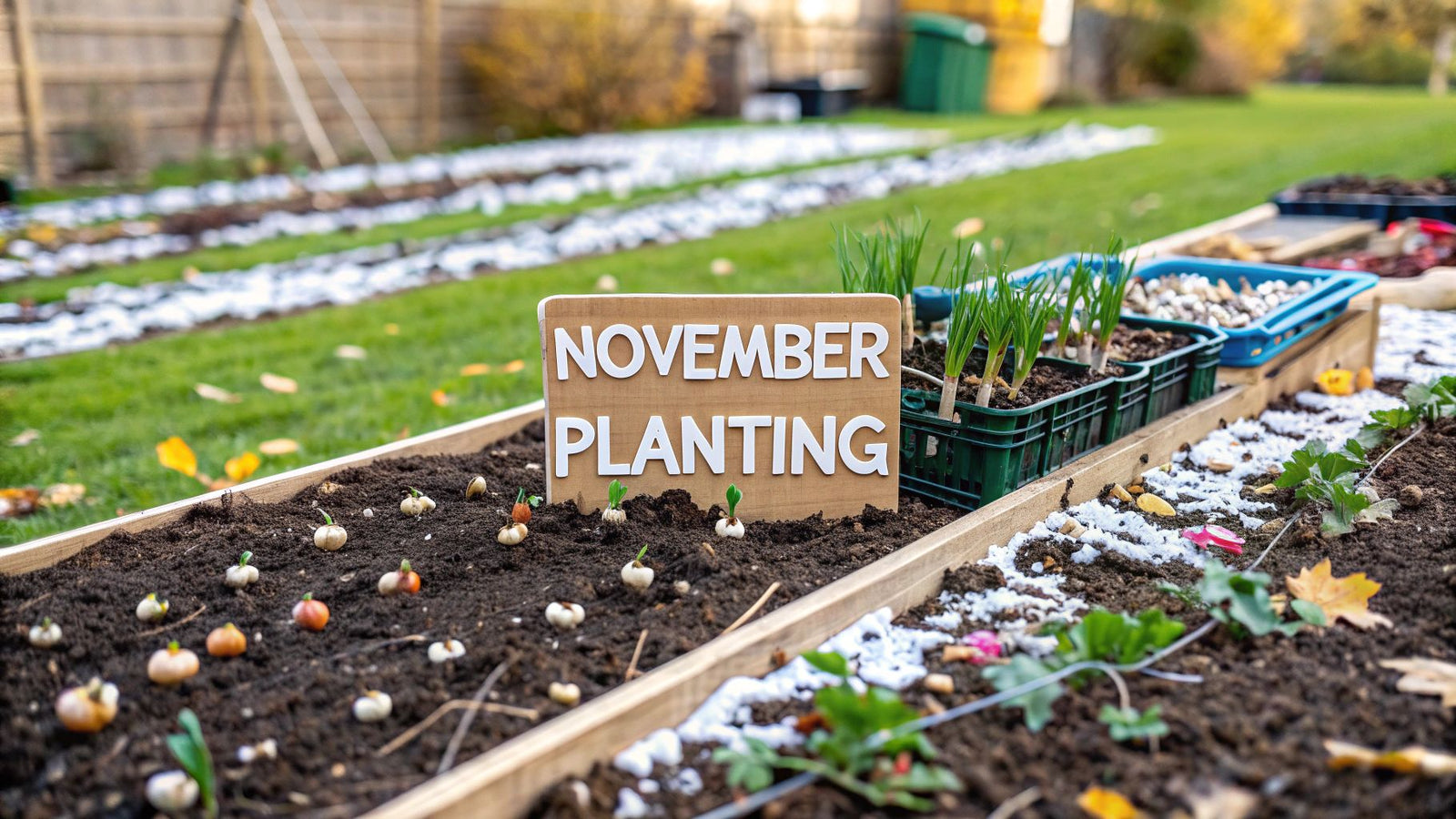
Just because the air has a bite to it doesn't mean your garden is shutting down for the year. Far from it! November is an incredible opportunity to get a jump on the next season, whether you're aiming for a hardy winter harvest or a jaw-dropping spring flower show. It's the perfect time to tuck in frost-sweetened vegetables, spring-flowering bulbs that need that winter chill, and cover crops to feed your soil for the year ahead.
Your Guide to November Planting Success
It's easy to think of November as a "down season" for gardening, but I like to think of it as the secret head start to a more beautiful and productive garden. When you plant now, you're working with cool soil, which is fantastic for establishing strong, healthy root systems without the stress of summer heat. You're really investing in your garden's future, laying the groundwork when most other garden chores are done.
We can break down the best November planting options into four key groups:
- Cool-Season Vegetables: Many veggies, like garlic and a lot of leafy greens, actually get sweeter and more flavorful after a light frost.
- Spring-Flowering Bulbs: Flowers like tulips and daffodils absolutely require a long cold nap—a process called vernalization—to get the signal to burst into bloom come spring.
- Hardy Herbs: A surprising number of resilient herbs can keep providing fresh flavor through the cold months, especially if you give them a protected spot.
- Essential Cover Crops: Think of these as a living green blanket for your soil. They prevent erosion and pack the ground full of nutrients for next year's plants.
This infographic gives a great visual breakdown of what you can focus on for a successful November garden.
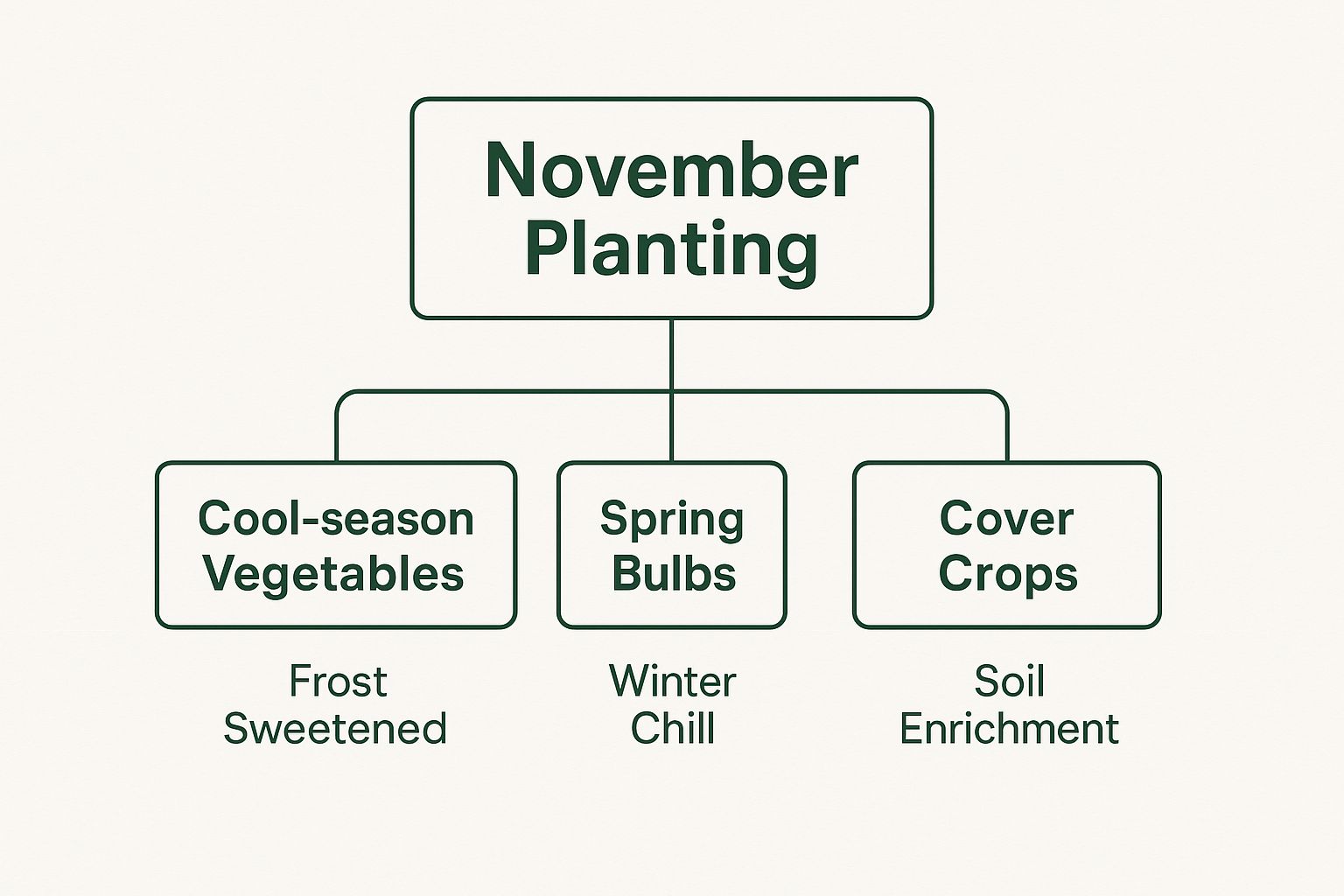
November Planting at a Glance
To make it even simpler, here’s a quick table that summarizes what to plant this month and why it works so well.
| Plant Category | Why Plant in November | Examples |
|---|---|---|
| Cool-Season Veggies | Cool soil encourages root growth, and frost can improve the flavor of many crops. | Garlic, Onions, Shallots, Kale, Spinach |
| Spring Bulbs | They require a mandatory cold period (vernalization) to trigger spring flowering. | Tulips, Daffodils, Crocus, Hyacinths |
| Hardy Herbs | Tough herbs can establish roots now and provide fresh cuttings in milder climates. | Rosemary, Thyme, Sage, Chives |
| Cover Crops | Protects and enriches soil over winter, preventing erosion and adding nutrients. | Winter Rye, Hairy Vetch, Clover |
This table should give you a solid starting point for your late-fall gardening plans.
As you can see, November planting is all about working with the cold, not against it. But before you start digging, make sure your garden beds are ready for winter. Our guide on https://homegrown-garden.com/blogs/blog/how-to-winterize-garden-beds walks you through the essential prep steps. And for a broader perspective, these general fall planting tips can really help round out your strategy.
7 Hearty Vegetables for a Winter Harvest
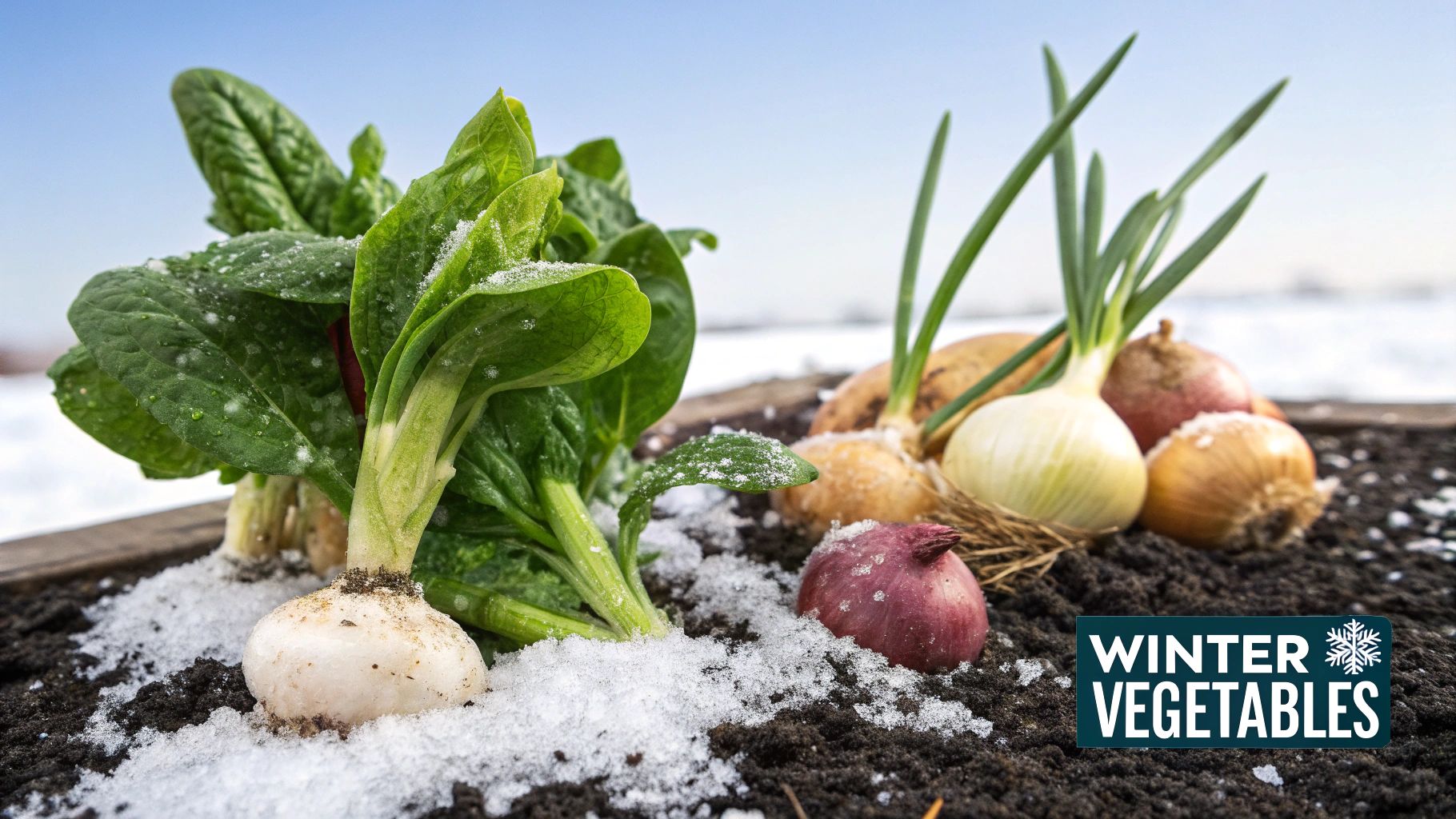
Don't hang up your trowel just yet! November gardening isn't about winding down; it's about leaning into the magic of the cold season. You'd be surprised how many vegetables not only survive a chill but actually get better after a light frost, which coaxes out their sweetness by turning starches into sugars.
Getting these seven tough-as-nails vegetables into the ground now is the perfect way to set yourself up for delicious harvests when the garden would otherwise be bare.
1. Garlic, 2. Onions, and 3. Shallots
These kitchen staples are the unsung heroes of the fall garden. They're wonderfully low-maintenance—just plant them in November and pretty much forget about them until spring.
When you plant individual garlic cloves, onion sets, or shallot bulbs now, you're giving them the entire winter to develop strong, deep roots. That extended cold period, a process called vernalization, is a critical trigger for garlic. It’s nature’s signal to form those big, plump bulbs we all love come summer. Just make sure they have a sunny spot with good drainage to keep them from getting waterlogged.
Planting garlic is an act of faith in the coming spring. Burying a single clove in the cold ground and trusting it to emerge as a full head is one of gardening's simplest and most profound rewards.
4. Broad Beans and 5. Peas
If you’re already dreaming of fresh, green flavors, now is the time to act. Sowing broad beans and specific winter-hardy pea varieties in November gives you a massive jump on the spring growing season.
These legumes will happily sprout in the cool soil and grow at a snail's pace through winter. Once the days start getting longer, they’ll take off, ready to produce weeks before spring-sown crops. A little support from a small trellis is a good idea, and you might want to protect the tender young shoots from biting winds with a bit of garden fleece or a cloche.
6. Asparagus
Think of planting asparagus as a delicious long-term investment. You won't be harvesting spears next spring, but by planting crowns in November, you're laying the groundwork for decades of gourmet harvests.
Find a sunny, well-drained spot and dig a trench, enriching the soil with a generous amount of compost. By getting the crowns in the ground now, their extensive root systems can settle in over the winter without the pressure of summer heat. Your patience will be rewarded with up to 20 years of fresh asparagus from this one planting.
7. Hardy Leafy Greens
Finally, you can’t have a winter garden without greens! Many leafy favorites like specific varieties of spinach, kale, and winter lettuces are incredibly resilient to the cold.
Planting them in November means you can snip fresh leaves for salads and sautés when almost everything else has gone dormant. For even more ideas, check out our guide on other great vegetables to plant for the fall season. These greens are perfect for tucking into cold frames or even containers for an extra layer of protection.
8 Spring Bulbs for a Burst of Color
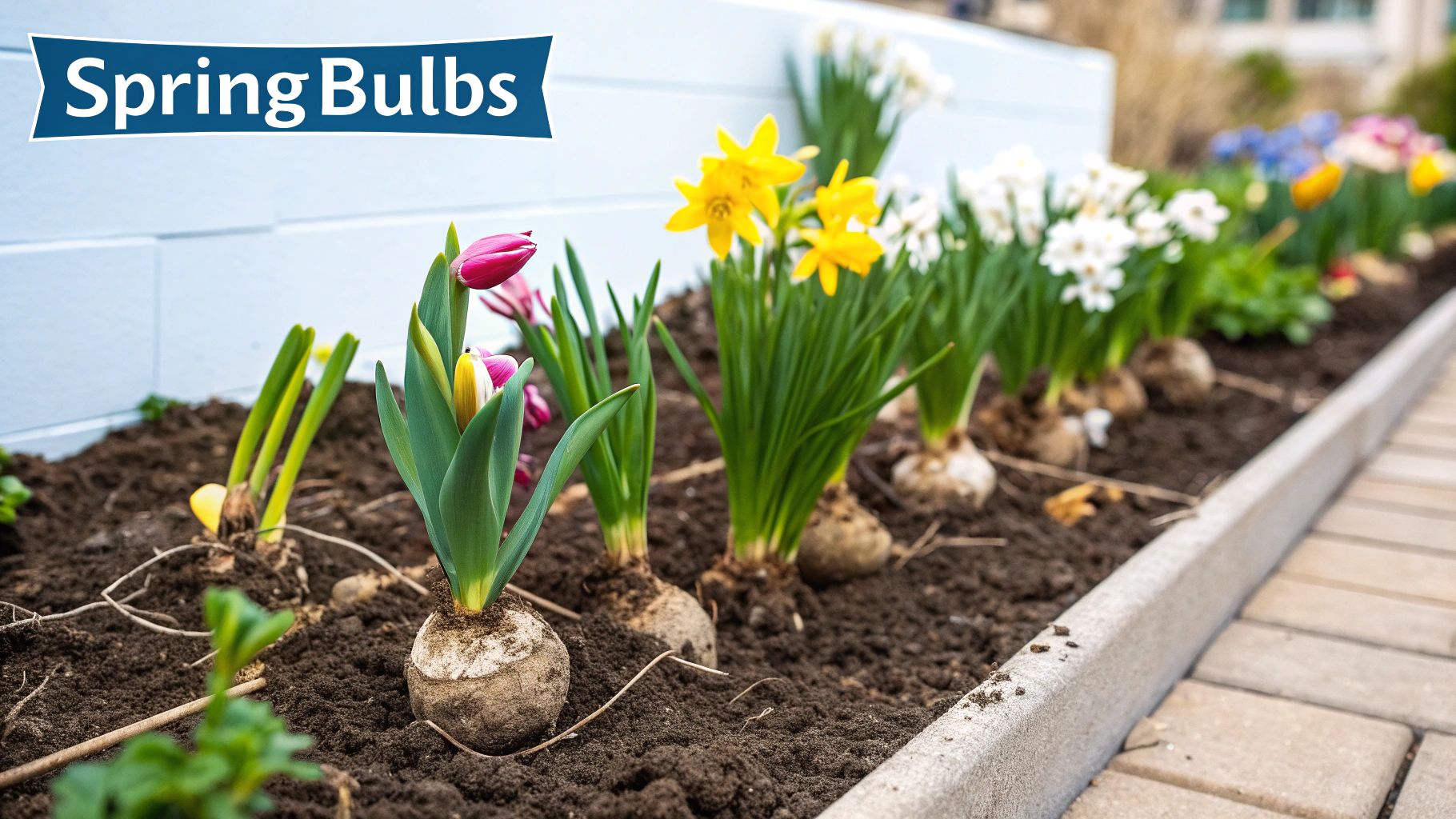
Planting bulbs in the fall always feels like stashing away a secret treasure for the spring. It’s an act of faith, tucking these small, unassuming packages into the cold ground, knowing they'll erupt into a wave of spectacular color once winter finally gives up its ghost.
So why November? It's the perfect window because these bulbs need a long, cold nap to kickstart their blooming process. This chilling period, known as vernalization, is non-negotiable. Without it, you'll get lackluster flowers or none at all. Getting them in the ground now gives them the full winter experience they crave to put on their best show.
Getting Your Bulbs in the Ground
How you plant your bulbs makes all the difference. Get it right, and you’re set for a glorious display. Get it wrong, and you might end up with weak stems or rotted bulbs, which is a real heartbreaker after waiting all winter.
The golden rule is simple: plant bulbs at a depth three times their height. A 2-inch tulip bulb? Dig a 6-inch hole. This little bit of math protects them from frost and gives them a solid anchor to grow strong and tall. Don't forget to give them some elbow room, too—usually a few inches apart is perfect.
Here's a pro tip for a truly stunning look: plant your bulbs in dense, natural-looking clusters instead of rigid, straight lines. It creates a much more dramatic and beautiful drift of color that looks like it came straight from a meadow.
Our Top 8 Picks for a Stunning Spring
Ready to start digging? Here are eight of our favorite, can't-miss bulbs for November planting. This mix gives you a fantastic range of colors, heights, and bloom times, ensuring your garden puts on a show from the last frost to the first days of summer.
- Tulips: The undisputed stars of spring, available in a mind-boggling array of colors and shapes.
- Daffodils (Narcissus): Cheerful, sunny, and best of all, pests like deer and squirrels absolutely hate them.
- Hyacinths: Famous for their tightly packed flower spikes and an incredible, sweet perfume that will fill your garden.
- Crocuses: These little troopers are often the very first flowers to say hello, sometimes even pushing their way through a late-season snow.
- Alliums: The rockstars of the bulb world, these ornamental onions send up dramatic, globe-shaped purple flowers on tall, slender stems.
- Grape Hyacinths (Muscari): Perfect for creating a carpet of deep, beautiful blue. These tiny bulbs are super easy to grow and spread nicely.
- Snowdrops (Galanthus): With their delicate, drooping white heads, these are one of the most welcome signs that winter is on its way out.
- Siberian Squill (Scilla siberica): If you want a patch of brilliant, true-blue flowers that will multiply over the years, this is the bulb for you.
4 Hardy Herbs That Defy the Cold
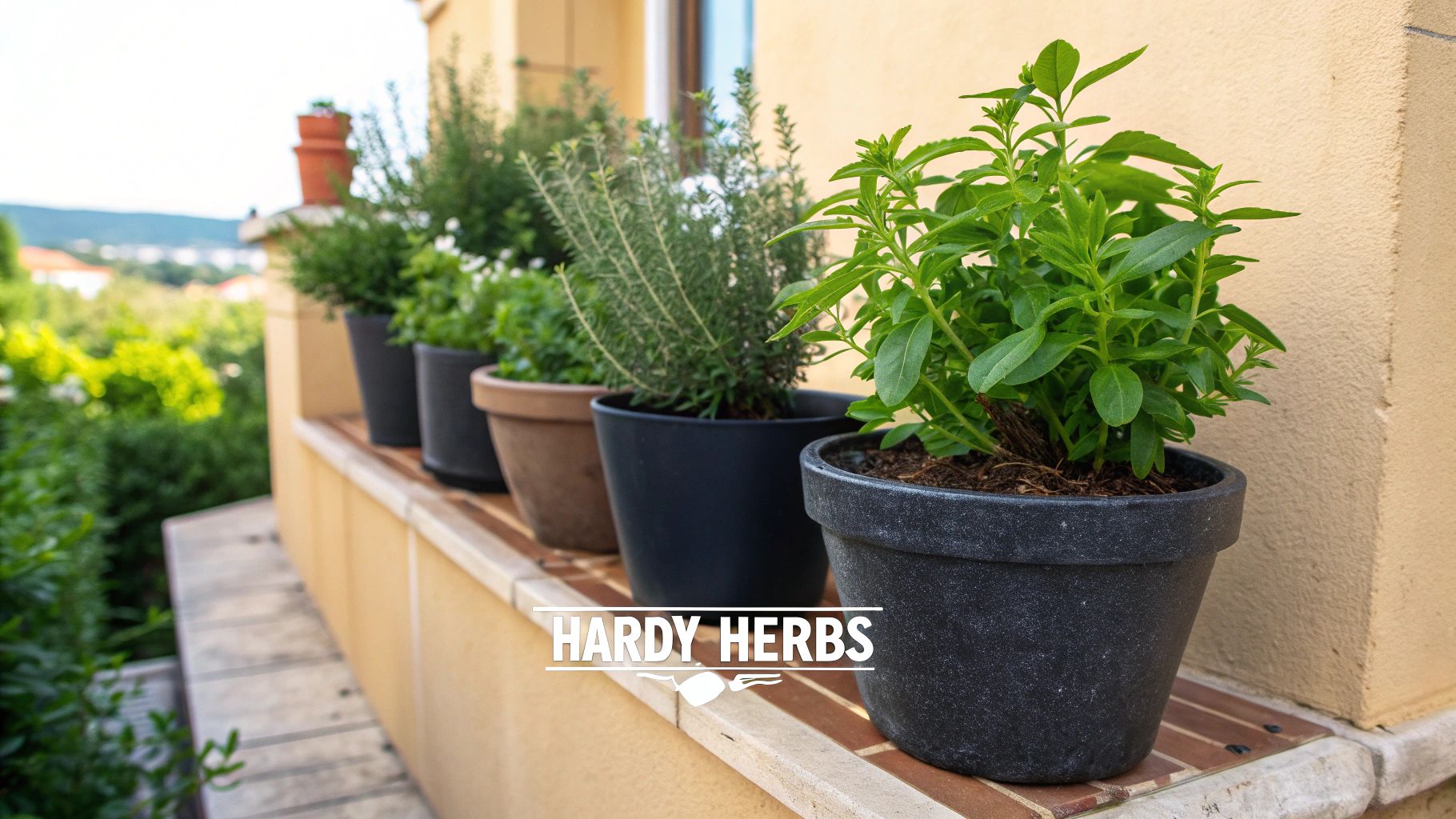
November isn't just for putting the garden to bed. It’s the perfect time to plant some incredibly tough, woody herbs that will keep your kitchen stocked with fresh flavor all through the winter. Getting them in the ground now gives their roots a chance to get established before the serious cold sets in.
The biggest enemy for these herbs isn't the cold itself—it's wet feet. Excellent drainage is non-negotiable. Think of it this way: their roots can handle chilly temperatures, but they’ll quickly rot if they’re stuck in cold, soggy soil. Popping them into a raised bed, a container, or even a sandy spot in your garden is the best way to ensure they thrive.
Top 4 Herb Picks for November
These four culinary workhorses are known for their resilience, and the chill often makes their flavor even more concentrated and intense.
- Rosemary: This Mediterranean native craves a sunny, sheltered location. Try planting it against a south-facing wall. The wall will soak up sun during the day and radiate warmth back at night, giving the plant a little microclimate of its own.
- Thyme: Incredibly hardy and low-growing, thyme is a fantastic, fragrant groundcover. Its tiny leaves pack a huge flavor punch, and once it's established, it asks for very little in return.
- Sage: You can't have holiday cooking without sage. Its flavor actually gets deeper and more complex after a light frost, making it an ideal candidate for November planting.
- Winter Savory: The name says it all. This peppery herb is built for the cold and adds a robust kick to all those hearty winter stews and roasts.
A simple layer of mulch, like straw or shredded bark, is like a winter blanket for your herbs. It insulates the roots, helps regulate the soil temperature, and gives them that extra bit of protection against the harshest freezes.
2 Essential Cover Crops to Protect Your Soil
Just because your vegetable beds are empty doesn't mean the work is done. Leaving your garden soil bare all winter is an open invitation for trouble—wind and rain can easily strip away your valuable topsoil, and weeds will jump at the chance to take over.
Think of cover crops as a living blanket for your garden. Planting them in November is the perfect way to tuck your soil in for a long winter's nap, protecting it from the elements while actively making it better for next year.
These plants are often called "green manure" for a good reason. In the spring, you simply turn them back into the earth, where they decompose and release a huge boost of organic matter. It’s one of the best ways to build rich, healthy soil season after season.
2 Powerhouse Plants for Soil Health
You don't need a huge variety to see massive benefits. For a November planting, a couple of options stand out as true workhorses for any home garden.
-
Winter Rye: If you need a tough, no-fuss option, this is it. Winter rye germinates quickly even in chilly soil. Its incredibly dense, fibrous root system is a champion at holding soil in place to prevent erosion and is fantastic for breaking up heavy, compacted clay. As a bonus, it soaks up any leftover nitrogen in the soil, locking it in so it doesn't wash away with winter rains.
-
Hairy Vetch: This plant is a soil-building superstar. As a legume, hairy vetch has the amazing ability to pull nitrogen right out of the air and store it in its roots. It's essentially a free, all-natural fertilizer factory, giving you a ready supply of nitrogen for hungry crops like corn and tomatoes next spring.
When you plant a legume like hairy vetch, you're not just covering the soil; you're actively enriching it. This natural nitrogen-fixing process reduces your need for fertilizers and builds a more self-sustaining garden ecosystem.
Sowing is a breeze. Just scatter the seeds evenly over your prepared beds and gently rake them into the top inch of soil. When spring rolls around, you’ll have a lush green carpet ready to be incorporated back into the garden, leaving you with dark, crumbly soil that’s teeming with life.
When you're out in your garden this November, figuring out what to tuck into the soil, it's pretty cool to remember you're part of a much bigger story. Farmers all over the world are doing the exact same thing, just on a much, much larger scale. Your backyard patch is a tiny piece of a massive global food system, all moving with the rhythm of the seasons.
November is a huge month for the staple crops that feed billions of people. It’s a key window for sowing winter wheat, one of the most fundamental grains on the planet. At the same time, farmers in the Southern Hemisphere are planting enormous fields of soybeans, a cycle that has a direct ripple effect on global food markets and the prices we pay.
2 Key Crops Planted on a Global Scale
Taking a peek at these large-scale planting cycles gives you a new appreciation for what's happening in your own garden. It shows how November's specific climate conditions are being put to work everywhere to grow food.
-
Winter Wheat in Europe and Russia
Across the European Union and Russia, November is a make-or-break month for planting winter wheat. In Russia alone, winter wheat accounts for about 90% of all winter grain crops. While the planting can start as early as September, it often stretches into early November as farmers wait for the perfect soil moisture before the ground freezes solid. You can get a deeper look at this crucial planting cycle in this agricultural report. -
Soybeans in South America
While we're pulling on sweaters in the Northern Hemisphere, spring is in full swing down south. For agricultural giants like Argentina and Brazil, November is prime time for planting soybeans. This opposite-season schedule is what ensures the world has a steady supply of this incredibly important crop year-round.
This global perspective is a great reminder that gardening is a universal language. The same core principles of timing, patience, and working with the seasons apply whether you're planting a single garlic clove or a thousand-acre field. We're all connected by these cycles of the earth.
Knowing the right time to get seeds in the ground is everything, whether you're farming a few pots or a few hundred acres. For more tips on timing your own garden plantings, check out our guide on when to plant vegetable seeds.
Frequently Asked Questions About November Gardening
Even those of us with dirt under our fingernails year-round have questions when November rolls around. The shift from crisp fall to the first hints of winter can feel tricky, but it also opens up some fantastic gardening opportunities. Let's tackle some of the most common questions about getting plants in the ground this month.
Is It Too Late to Plant in November?
Not at all! In fact, for a surprising number of plants, November is the perfect time. Think of it as giving them a head start for next year.
Spring-flowering bulbs like tulips and daffodils are a great example; they must have a winter chill to trigger their blooming cycle. Getting them in the ground now is exactly what they need. The same goes for garlic and shallots, which use the cool, dormant season to establish a robust root system, setting them up for explosive growth once spring arrives.
How Do I Protect New Plants from Frost?
Protecting your new additions from a hard freeze is crucial, but it's easier than you might think. Your first and best line of defense is a thick layer of mulch—think straw, shredded leaves, or even pine needles. This acts like a cozy blanket for the soil, insulating roots from the shock of sudden temperature drops.
For plants that are a bit more tender, you may need to give them some extra cover when a deep freeze is in the forecast.
- A cold frame is a great mini-greenhouse for a whole patch of greens.
- A cloche works wonders for protecting individual plants.
- A frost blanket can be easily draped over entire rows for the night.
Just be sure to pull the covers back off in the morning. You want your plants to get that precious sunlight and fresh air.
Can I Still Plant in Containers in November?
Absolutely. Container gardening is a fantastic way to keep growing through the cooler months. A good tip is to use larger pots than you might in the summer; the extra soil provides more insulation for the roots, protecting them from freezing solid.
The single most important thing for winter containers is drainage. Soggy soil is bad enough, but frozen, waterlogged soil is a death sentence for roots. Make sure every pot has plenty of drainage holes.
Hardy herbs, smaller bulbs, and tough leafy greens like winter lettuce do wonderfully in pots. The best part? If an arctic blast is headed your way, you can just pick them up and move them to a more sheltered spot, like right up against the house or onto a covered porch.



